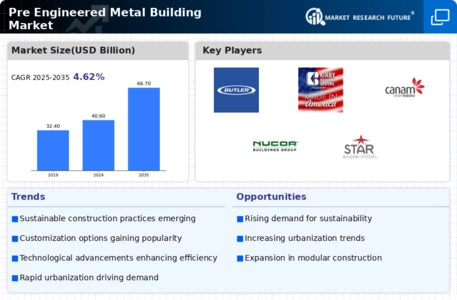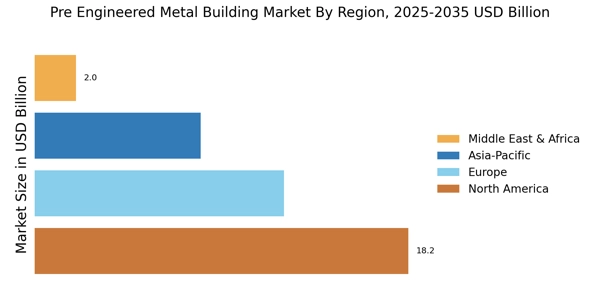Cost Efficiency
The Pre Engineered Metal Building Market is experiencing a surge in demand due to its cost-effective construction solutions. These buildings typically require fewer materials and less labor compared to traditional construction methods, leading to significant savings. According to recent data, the average cost of pre-engineered buildings can be 30% lower than conventional structures. This cost efficiency is particularly appealing to businesses looking to minimize overhead while maximizing functionality. Furthermore, the speed of construction associated with pre-engineered metal buildings reduces project timelines, allowing companies to realize returns on investment more quickly. As a result, the cost efficiency of pre-engineered metal buildings is a primary driver in the market, attracting a diverse range of industries from manufacturing to retail.
Customization and Flexibility
The Pre Engineered Metal Building Market offers a high degree of customization and flexibility, which is increasingly important for businesses seeking tailored solutions. These buildings can be designed to meet specific requirements, including size, layout, and functionality, allowing for a wide range of applications from industrial to commercial use. The ability to modify designs easily and incorporate various features, such as insulation and ventilation systems, enhances their appeal. Market data suggests that customization options can lead to a 20% increase in customer satisfaction, as businesses can create spaces that align with their operational needs. This flexibility not only attracts new customers but also encourages repeat business, thereby driving growth in the pre-engineered metal building sector.
Durability and Low Maintenance
Durability is a key attribute of the Pre Engineered Metal Building Market, as these structures are designed to withstand harsh weather conditions and resist corrosion. The materials used in pre-engineered buildings, such as galvanized steel, provide longevity and require minimal maintenance over time. This durability translates into lower lifecycle costs for owners, as they do not need to invest heavily in repairs or replacements. Data indicates that pre-engineered metal buildings can last up to 50 years or more with proper care. This aspect is particularly appealing to sectors such as agriculture and warehousing, where long-term investment in infrastructure is crucial. Consequently, the durability and low maintenance requirements of pre-engineered metal buildings significantly contribute to their growing popularity in various markets.
Sustainability and Energy Efficiency
Sustainability is becoming a pivotal driver in the Pre Engineered Metal Building Market, as more companies prioritize environmentally friendly construction practices. Pre-engineered metal buildings can be designed to be energy-efficient, utilizing materials that reduce energy consumption and lower carbon footprints. Features such as reflective roofing and energy-efficient insulation contribute to significant energy savings, which can be as much as 30% compared to traditional buildings. Additionally, the use of recyclable materials in construction aligns with global sustainability goals, appealing to environmentally conscious consumers. As businesses increasingly seek to enhance their sustainability profiles, the demand for energy-efficient pre-engineered metal buildings is likely to rise, further propelling market growth.
Rapid Urbanization and Infrastructure Development
Rapid urbanization and infrastructure development are driving forces behind the Pre Engineered Metal Building Market. As populations grow in urban areas, the demand for commercial and residential spaces increases, necessitating efficient construction solutions. Pre-engineered metal buildings provide a quick and effective response to this demand, allowing for the rapid establishment of facilities such as warehouses, retail spaces, and manufacturing plants. Recent statistics indicate that urban areas are expected to see a 60% increase in population by 2030, further intensifying the need for innovative building solutions. This trend not only supports the growth of the pre-engineered metal building market but also positions these structures as essential components in the development of modern urban landscapes.


















Leave a Comment